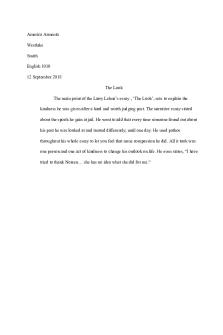English Analysis Techniques PDF

| Title | English Analysis Techniques |
|---|---|
| Course | English: Advanced English |
| Institution | Higher School Certificate (New South Wales) |
| Pages | 2 |
| File Size | 57.3 KB |
| File Type | |
| Total Downloads | 115 |
| Total Views | 150 |
Summary
Table of all english techniques needed for analysis - useful for all modules...
Description
ECHNIQUE Alliteration Allegory
DESCRIPTION Starting multiple words with the same letter A story or narrative with 2 meanings – the literal meaning and then a hidden meaning (hidden meaning acts as commentary on the real world) Ambiguity When something is left to the reader’s imagination – often involves the author not stating explicitly what is happening/being said Anaphora Beginning multiple statements with the same word/s Anthropomorph Attributing human qualities to a non-human figure to make it seem more human i.e., Thomas the tank engine ism Apostrophe Rhetorical technique where a character speaks to an object, quality or idea or discusses somebody who is absent or dead Antithesis Using two sentences with contradictory/contrasting means to another, sometimes even in immediate succession Archetype An immediately recognisable character, concept or object that makes it easy for the audience to categorise them based on what they resemble in literature Assonance Repetition of a vowel sound within a word Connotation The ideas + qualities associated with a word – may be positive or negative (violent connotations, connotations of grief, connotations of peace etc.) Consonance Repetition of consonants throughout a sentence or phase Context Time, place, and social setting within which a text was creates, including the values of the time, world events, major topics of discussion, key figures etc. Dramatic Irony Any situation wherein the audience is privy to some sort of information that the characters do not know, building audience tension, suspense etc. Emotive Words chosen to create a specific emotional response in the reader, often linked to world’s connotations and language commonly used in descriptive situations Enjambment When a sentence continues across the end of a line of poetry or across multiple stanzas – essentially starting a new line mid-sentence Epistrophe Ending multiple statements with the same word/s Euphemism A mild or ‘proper’ expression used to replace one that is harsh, blunt, or otherwise offensive in order to not cause trouble Figurative Language, words, and/or expressions that have meaning beyond their literal interpretation, often used to language express links between ideas. Characters and concepts or subtly tie into overall themes Fractured Incomplete or broken sentences used most commonly in dialogue to replicate regular speech patterns and being sentences cut off/trailing while speaking Fragmented Incomplete sentences used to increase tension or urgency or reflect the way people speak to each other sentences Hyperbole A dramatic exaggeration to create a more intense or over-the-top effect
Intertextual reference Irony Juxtaposition Linear/nonlinear Metaphor Metonymy Modality Motifs Omission Onomatopoeia Pathetic fallacy Personification Repetition Rhetorical question Satire Sibilance Stream of consciousness Symbolism Syntax Theme Tone Diction Zoomorphism
The inclusion of a quote, character, or place from another text A disconnect between what is said and what is meant, usually with words said having a second insulting, humorous, or satirical meaning Putting two opposite sentences next to each other to emphasise the differences The way in which a narrative flows or is told Comparing two things by saying one “is” the other – creating a non-literal image A word or name that is used in the place of something that it is closely related to The certainty which a speaker employs in their language An image, sound, figure, character, or object which has a symbolic reference to a particular theme or idea Parts excluded from a text A word that echoes the sound it represents Attribution of human emotions to objects of nature – weather dictates the mood Human characteristics given to a non-human object i.e., the wind howled Repetition of words or syntax for emphasis or persuasion A question that does not require an answer Composition which ridicules in a scornful and humorous way The repetition of soft consonant sounds Authors use a stream of consciousness style of writing to mimic the way we think inside our own heads. Often ignores normal punctuation and grammatical structure When an object represents one or more (often complex) ideas Refers to the organisation of words and phrases in a sentence Message or moral of a story The way the composer or character feels – conveyed by word choice Word choice – i.e., emotive, forceful, factual, descriptive, blunt, graphic, etc. Attribution of animal properties to non-animals i.e., my brother eats like a horse...
Similar Free PDFs

English Analysis Techniques
- 2 Pages

Techniques of English
- 7 Pages

Competitive analysis techniques
- 2 Pages

Essay Analysis - ENglish 101
- 6 Pages

English News Analysis
- 3 Pages

Media Analysis final - English
- 4 Pages

Narrative Analysis-English 1010
- 1 Pages
Popular Institutions
- Tinajero National High School - Annex
- Politeknik Caltex Riau
- Yokohama City University
- SGT University
- University of Al-Qadisiyah
- Divine Word College of Vigan
- Techniek College Rotterdam
- Universidade de Santiago
- Universiti Teknologi MARA Cawangan Johor Kampus Pasir Gudang
- Poltekkes Kemenkes Yogyakarta
- Baguio City National High School
- Colegio san marcos
- preparatoria uno
- Centro de Bachillerato Tecnológico Industrial y de Servicios No. 107
- Dalian Maritime University
- Quang Trung Secondary School
- Colegio Tecnológico en Informática
- Corporación Regional de Educación Superior
- Grupo CEDVA
- Dar Al Uloom University
- Centro de Estudios Preuniversitarios de la Universidad Nacional de Ingeniería
- 上智大学
- Aakash International School, Nuna Majara
- San Felipe Neri Catholic School
- Kang Chiao International School - New Taipei City
- Misamis Occidental National High School
- Institución Educativa Escuela Normal Juan Ladrilleros
- Kolehiyo ng Pantukan
- Batanes State College
- Instituto Continental
- Sekolah Menengah Kejuruan Kesehatan Kaltara (Tarakan)
- Colegio de La Inmaculada Concepcion - Cebu








